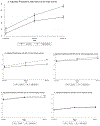Transition to independent care for youth living with HIV: a cluster randomised clinical trial
- PMID: 36309040
- PMCID: PMC10308660
- DOI: 10.1016/S2352-3018(22)00244-2
Transition to independent care for youth living with HIV: a cluster randomised clinical trial
Abstract
Background: Transitioning youth living with HIV to adult care is a crucial step in the HIV care continuum; however, tools to support transition in sub-Saharan Africa are insufficient. We assessed the effectiveness of an adolescent transition package (ATP) to improve youth readiness for transition to independent HIV care.
Methods: In this hybrid type 1, multicentre, cluster randomised clinical trial, we assessed the effectiveness of an ATP (administered by routine clinic staff, which included standardised assessments and chapter books to guide discussions at scheduled clinic visits) in four counties in Kenya, with HIV clinics randomly assigned 1:1 to ATP or control (standard-of-care practice). Clinics were eligible to participate if they had at least 50 youth (aged 10-24 years) living with HIV enrolled in care. We used restricted randomisation to achieve cluster balance and an independent biostatistician used computer-generated random numbers to assign clinics. We excluded very large clinics with more than 1000 youth, clinics with fewer than 50 youth, paediatric-only clinics, clinics with logistical challenges, and the smallest clinics in Homa Bay county. Youth were eligible for the transition intervention if they were enrolled in participating clinics, were aged 15-24 years, and were aware of their positive HIV diagnosis. Study staff assessed transition readiness scores overall and by four domains (HIV literacy, self-management, communication, and support) in youth with HIV, which were then compared between groups by use of mixed-effects linear regression models. Analysis was by intention-to-treat and was adjusted for multiple comparisons. This trial is registered with ClinicalTrials.gov, NCT03574129.
Findings: We identified 35 clinics in four counties; of these, ten were assigned to the intervention group and ten to the control group. Of 1066 youth with HIV enrolled between Nov 1, 2019, and March 18, 2020, 578 (54%) were in intervention and 488 (46%) in control sites. Mean baseline transition readiness score was 12·1 (SD 3·4) in ATP sites and 11·4 (3·7) in control sites. At 1 year, adjusting for baseline scores, age, and months since HIV disclosure, participants in the ATP group had significantly higher overall transition readiness scores (adjusted mean difference 1·7, 95% CI 0·3-3·1, p=0·024), and higher scores in HIV literacy domain (adjusted mean difference 1·0, 0·2-1·7, p=0·011). At 12 months, 15 serious adverse events were recorded, none of which were thought to be related to study participation.
Interpretation: Integrating ATP approaches could enhance long-term HIV care in youth with HIV as they age into adulthood.
Funding: US National Institutes of Health.
Copyright © 2022 Elsevier Ltd. All rights reserved.
Conflict of interest statement
Declaration of interests BAR reports payments from Gilead for participation in data safety monitoring boards. GJ-S reports support from the US National Institutes of Health (NIH) and IMPAACT. INN reports support from NIH, Gilead Sciences, and the UW Center for AIDS Research. The other authors declare no competing interests.
Figures



Comment in
-
Transitioning youth living with HIV to adult HIV care.Lancet HIV. 2022 Dec;9(12):e810-e811. doi: 10.1016/S2352-3018(22)00303-4. Epub 2022 Oct 26. Lancet HIV. 2022. PMID: 36309039 No abstract available.
References
Publication types
MeSH terms
Substances
Associated data
Grants and funding
LinkOut - more resources
Full Text Sources
Medical

